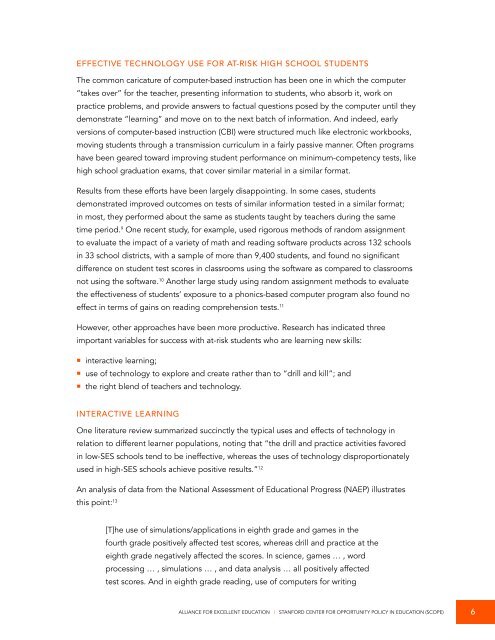3JzsFOnhn
3JzsFOnhn
3JzsFOnhn
You also want an ePaper? Increase the reach of your titles
YUMPU automatically turns print PDFs into web optimized ePapers that Google loves.
EFFECTIVE TECHNOLOGY USE FOR AT-RISK HIGH SCHOOL STUDENTSThe common caricature of computer-based instruction has been one in which the computer“takes over” for the teacher, presenting information to students, who absorb it, work onpractice problems, and provide answers to factual questions posed by the computer until theydemonstrate “learning” and move on to the next batch of information. And indeed, earlyversions of computer-based instruction (CBI) were structured much like electronic workbooks,moving students through a transmission curriculum in a fairly passive manner. Often programshave been geared toward improving student performance on minimum-competency tests, likehigh school graduation exams, that cover similar material in a similar format.Results from these efforts have been largely disappointing. In some cases, studentsdemonstrated improved outcomes on tests of similar information tested in a similar format;in most, they performed about the same as students taught by teachers during the sametime period. 9 One recent study, for example, used rigorous methods of random assignmentto evaluate the impact of a variety of math and reading software products across 132 schoolsin 33 school districts, with a sample of more than 9,400 students, and found no significantdifference on student test scores in classrooms using the software as compared to classroomsnot using the software. 10 Another large study using random assignment methods to evaluatethe effectiveness of students’ exposure to a phonics-based computer program also found noeffect in terms of gains on reading comprehension tests. 11However, other approaches have been more productive. Research has indicated threeimportant variables for success with at-risk students who are learning new skills:• interactive learning;• use of technology to explore and create rather than to “drill and kill”; and• the right blend of teachers and technology.INTERACTIVE LEARNINGOne literature review summarized succinctly the typical uses and effects of technology inrelation to different learner populations, noting that “the drill and practice activities favoredin low-SES schools tend to be ineffective, whereas the uses of technology disproportionatelyused in high-SES schools achieve positive results.” 12An analysis of data from the National Assessment of Educational Progress (NAEP) illustratesthis point: 13[T]he use of simulations/applications in eighth grade and games in thefourth grade positively affected test scores, whereas drill and practice at theeighth grade negatively affected the scores. In science, games … , wordprocessing … , simulations … , and data analysis … all positively affectedtest scores. And in eighth grade reading, use of computers for writingALLIANCE FOR EXCELLENT EDUCATION | STANFORD CENTER FOR OPPORTUNITY POLICY IN EDUCATION (SCOPE) 6


